Moniek Bloks's Blog, page 156
February 2, 2021
The Habsburgs by Martyn Rady Book Review
The Habsburgs now live in people’s imagination as those rulers with the large jaw who eventually were so inbred that they died out. Now, this is not entirely true, and their legacy deserves more than that. They once ruled large parts of Europe and even of the New World and the Far East.
I imagined it would be quite difficult to fit all of this in one book, and it turns out… it was. Naturally, the book focuses heavily on the male side of things – they were the actual rulers, after all. I did find it rather disappointing that – especially in the first part of the book – very few women even receive a name, and when one finally did… it failed to mention that she was actually England’s first undisputed Queen Regnant. Poor Queen Mary I just can’t catch a break.
I also did not find the tiny jabs at women funny. Sophie of Bavaria, the mother of Emperor Franz Joseph I of Austria, is described as “tiresome,” but why exactly was she tiresome? We’ll never know. All in all, these moments made for very exasperated reading for me. I don’t know if this was intentional on the author’s part, but the lack of women in the story of the Habsburgs just simply didn’t do it for me. Of course, there’s Empress Maria Theresa as one of the main figures, but even her story does not seem to do her justice.
Overall, the book is well-researched and factually correct, and the writing style is quite pleasant if you can overlook the “tiresome” Sophie. It will serve well as an introduction into the Habsburg empire, but if you’re looking for the women, you won’t find many of them here.
The Habsburgs by Martyn Rady is available now in both the UK and the US.
The post The Habsburgs by Martyn Rady Book Review appeared first on History of Royal Women.
January 31, 2021
Maria Pia of Savoy – The penultimate Queen of Portugal (Part four)
Maria Pia spent much of the year 1888 scouring Europe to find a wife for her second son Afonso. However, he was quite against marriage, and the long trip eventually became a source of ridicule. She returned home without a new daughter-in-law and to a sick husband. When she attended the theatre shortly after her return, she was booed by the public, who felt it was inappropriate for her to be there while Luis was ill. However, their marriage was nothing but a shell now, and she felt no inclination to return to him. In fact, she wanted to go to Italy to live with her sister Clotilde. In February 1889, Maria Pia ended her relationship with Thomas de Sousa Rosa, but it was hard for her. Luis’s health was clearly deteriorating now, and she would remain with him until the end, even if that meant sacrificing her personal happiness once more.
While Luis’s health was failing, so was the health of his only surviving brother Augusto. The brothers decided to move to Sintra to avoid the heat in Lisbon. Maria Pia joined them there as well. Luis initially showed some signs of improvement, but he had long suffered from syphilis, and he eventually became paralyzed from the waist down. Luis suddenly decided he wanted to go to Cascais on the seaside, and on 23 September, the family set out for Cascais. There he could enjoy a view of the sea from the terrace of the Citadel. Maria Pia never left his side and slept behind a screen set up in his room so she could hear him if he called for her. Her devoted care for her dying husband was also good for her image, and her popularity with the public was promptly restored.
Augusto was the first to die on 26 September 1889. He had been moved to the Necissadades Palace a few days before his death. The death of Augusto was kept from Luis as long as possible, and on the day of Augusto’s funeral, Luis underwent an operation to remove gangrene from his legs. It would not help. Luis died on 19 October 1889 at 11.05 in the morning. Maria Pia announced the death of her husband to the waiting ministers herself with the words, “The King is dead. Long live the King” before telling her eldest son, “May you be as good a king as you have been a son.”1
Just two months after Luis’s death, Maria Pia welcomed a second grandson into the world as Amélie gave birth to Manuel. Maria Pia was there as he was born. Although it should have been a happy time for them, it was around this time that the Braganzas of Brazil were being deposed, and they now had to play hosts to their exiled relatives as well. Little did they know that the end of the Portuguese monarchy was also coming. During the years of Maria Pia’s widowhood, the political climate in Portugal worsened, and Maria Pia wrote to Antonia that she feared that Portugal would become a republic as well.
As Maria Pia emerged from her mourning, she also returned to spending extravagantly, although she never forgot about her charities in that spending either. She also remained politically active, which then led to more rivalry with her daughter-in-law, who resented being kept out of the political affairs by her husband. In fact, Carlos and Amélie’s marriage was deteriorating, and he wanted to have her only do ceremonial duties.
On 29 July 1900, Maria Pia’s brother King Umberto I of Italy was assassinated by an anarchist. Maria Pia and Afonso were one of the first relatives to arrive after his death as they had been staying nearby. He had been her only remaining brother, and she was devastated by his death. It was a horrible foreboding of things to come for her own son.
It happened on 1 February 1908. Carlos, Amélie, Luis Filipe and Manuel were returning to Lisbon in an open carriage. Their carriage was followed by several other carriages as it passed through the streets by crowds of onlookers. The first assassin Manuel Buíça emerged from the crowd with a rifle and aimed for Carlos. His shot went through Carlos’s spine and killed him instantly. A second assassin, Alfredo Costa, shot twice more at Carlos. Amélie and Luis Filipe both stood up with Luis Filipe pulling out a revolver. Costa aimed at Luis Filipe and shot him in the chest, but Luis Filipe also managed to fire four rounds into his assassin – killing him. Luis Filipe was then shot in the face by Manuel Buíça. During the confusion, Manuel and the coachman were also injured, but the coachman still managed to drive the carriage away from the scene. Luis Filipe died a few moments later in the carriage.
Maria Pia was initially only informed that Carlos was injured but learned while en route that he had died. Upon arrival, she threw herself on his body, crying, “My son has been murdered!”2 To this, Amélie responded, “And mine too!”3 Then Maria Pia noticed the body of Luis Filipe, and she fainted. Amélie had remained unharmed while Manuel had been shot in the arm and was being attended to. The remaining family members returned to the Necessidades Palace later that day, where Maria Pia remained in stoic grief. Diarist Raul Brandou wrote, “The old Queen sat in a chair, without a word, without a tear, her glassy eyes fixed on the wall. And in this manner she stayed for hours, as unmoving as a rock.”4
After the deaths of her son and grandson, Maria Pia suffered a mental breakdown. She began to talk to herself, saw blood spatters in her rooms, did not sleep and had to be forced to eat. Along with her mental breakdown, her physical health also suffered. There was even some talk of having her committed to an insane asylum. The reign of her grandson Manuel was to be short – he was deposed on 5 October 1910. Maria Pia joined Manuel and Amélie as they left for exile, but she did not want to go to England with them, preferring to return to her native Italy. On 18 October 1910, her nephew King Victor Emmanuel III escorted her from her ship onto Italian soil. She stayed with them for some time before visiting her sister Clotilde and finally going to Naples, where she intended to settle. On 2 December, she was joined there by her second son Afonso whom she embraced, crying tears of joy.
In June 1911, Maria Pia hurried to be by her sister’s side as she lay dying at Moncalieri. As she died on 25 June, Maria Pia kissed her forehead and said, “Clotilde, I will soon follow.”5 She managed to return to her apartments at the Stupinigi Palace, where she had several uremic attacks. On 5 July 1911 at 3.15 in the afternoon, Maria Pia, Queen of Portugal, died in the arms of Queen Margherita, her sister-in-law, with her face turned towards Portugal as requested. Margherita later wrote, “She had suffered too many horrific wounds to withstand this last sorrow6.”7
She was interred in the Savoy family vault at The Basilica of Superga. Her wish to be returned to Portugal has remained unfulfilled.
The post Maria Pia of Savoy – The penultimate Queen of Portugal (Part four) appeared first on History of Royal Women.
January 30, 2021
Maria Pia of Savoy – The penultimate Queen of Portugal (Part three)
Her many charitable acts could not silence her critics, and she was known to retort, “Those that want Queens should pay.”1 It didn’t help that her main critics were her father-in-law Ferdinand, King by right of his wife Queen Maria II until her death in 1853, and his morganatic second wife, Elise. Luis’s sister Antonia once wrote to her brother, “She (Elise) does all she can to discredit Maria. I will never forget the scene I had with her… when I said that Maria had pleased me… and she said that the Queen speaks accordingly to the people she speaks to and I told her that it would not be polite to talk about my sister so I called Father so we could talk about something else.”2 Ferdinand and Elise were eventually forced into retirement.
On 9 January 1878, Maria Pia’s father, King Victor Emmanuel II of Italy, died at the age of 57. Although she arrived too late at his deathbed, she remained in Italy for the funeral. Her brother had now become King Umberto I of Italy. Maria Pia’s beloved sister Clotilde had desperately written to their father shortly before his death to tell him about the state of her marriage. Her philandering husband had abandoned her and taken her two sons from her care. Luckily, their brother was able to help her and her daughter Maria Letizia and put Moncalieri Castle at their disposal.
The following year, Maria Pia herself developed a serious illness – pleurisy. People from all ranks in life gathered outside the Palace for information about her health. As she slowly recovered from her illness, Te Deums were performed in the churches of the city.
The years 1884 and 1885 saw the deaths of Maria Pia’s sister-in-law and her father-in-law. In 1884, her sister-in-law Maria Anna (married to Prince George of Saxony and mother of King Frederick Augustus III of Saxony) died at the age of 41 of typhoid fever after nursing her youngest son Albert through the same disease. The following year, Ferdinand, who had been suffering from cancer, collapsed at the opera and died shortly after at the age of 69. Ferdinand was buried next to Queen Maria and the seven children that had predeceased him.
Maria Pia and Luis now focussed their attentions on finding a bride for their eldest son Carlos and the search began among the Coburg relatives – preferably a granddaughter of Queen Victoria. Viktoria of Prussia had her eye on someone else, so she refused him. Luis’s sister Antonia tried to steer them towards Catholic Princesses, such as Princess Maria Josepha of Saxony – the daughter of their sister Maria Anna and thus Carlos’s first cousin – but decided against it. Eventually, she recommended the exiled House of Orléans, and they settled on Amélie of Orléans, the eldest daughter of Prince Philippe, Count of Paris and Princess Marie Isabelle of Orléans.
On 22 May 1886, Carlos and Amélie married in a grand wedding organised by Maria Pia. Maria Pia herself wore a blue velvet dress with a large peacock coloured train with white silk pomegranates, while the bride wore a high collared satin dress with an embroidered veil. A new era had begun, and while their son began his married life, the marriage of Maria Pia and Luis was beginning to show cracks.
Luis had never been entirely faithful to her, but he had always been discrete. He had even written a secret will once, leaving bequests to a mistress and their illegitimate son. However, he never quite followed through on having the will legalised. Maria Pia was aware of his liaisons, which she referred to as “out of doors amusements.”3 However, she became less tolerant of them as he became less discrete. During these years, the birth of her grandson Luis Filipe gave her joy, and he had a special place in Maria Pia’s heart. Tragically, Amélie and Carlos’s second child was a premature daughter who lived for just two hours. Maria Pia later described her little granddaughter as “very small, but perfect and beautiful, with well-defined features.”4 Maria Pia could certainly understand the loss. After her departure, Amélie wrote to Maria Pia, “I am very sad my dear Mother and in this sadness you have been so good to me.”5 Unfortunately, if the two women were close during this time, their relationship soon deteriorated significantly due to rivalry over charitable activities – but perhaps the fact that Maria Pia had taken a lover did not help either.
She had never been short of male admirers, but she had thus far remained faithful to Luis, even if he hadn’t been faithful to her. As her marriage deteriorated, she saw no reason to keep this up. Her chosen lover was Thomas de Sousa Rosa, and it probably began around 1886. None of their letters survive, but Luis’s sister Antonia – who had learned of the affair – often wrote of it to her brother. Antonia developed such hatred for her sister-in-law that she would later only refer to her as X in her letters. It was quite the double standard as Luis also continued to have affairs. Antonia found Maria Pia’s behaviour inexcusable and wrote that it was “bad in any woman, but in the position of X, doubly bad because it gives a bad example to all society and to all of the country.”6 Maria Pia remained indignant, saying, “They can talk until they explode.”7
Part four coming soon.
The post Maria Pia of Savoy – The penultimate Queen of Portugal (Part three) appeared first on History of Royal Women.
January 28, 2021
Maria Pia of Savoy – The penultimate Queen of Portugal (Part two)
As the news of the engagement spread around Europe, congratulations began pouring in. Queen Victoria was disappointed in Luis’s choice and wrote, “Naturally the change so sudden… in your opinion astonishes me greatly. But since you have made your choice, I have nothing more to say, except to wish that it will be alright and that you will be happy. What I regret is the extreme youth of Princess Maria Pia who… is hardly of an age to be useful to you. Let us always hope that she will possess all the qualities necessary for your wife and for a Queen.”1
A proxy wedding took place on 27 September 1862 with her cousin Prince Eugene of Savoy-Carignano standing in for the groom. On the 29th, Maria Pia boarded a Portuguese ship at Genoa to take her to her new homeland. The ship sailed into Lisbon on 5 October and anchored in front of Belem Palace where King Luis was waiting for her. Maria Pia later wrote, “I like him more than his picture.”2 The following day, a second wedding ceremony was performed at the church of Sao Domingos. Though perhaps believing herself in love at first, her husband turned out to be a disappointment to her. She also had trouble learning Portuguese, and she found her new ladies-in-waiting boring.
Fortunately, Maria Pia and Luis had been able to find an understanding, and despite being told not consummate the marriage too quickly because of Maria Pia’s age, Luis wasted no time. Within three months, she was pregnant with their first child – she was still only 15 years old herself. On 28 September 1863, Maria Pia gave birth to a son named Carlos. Despite her young age, she proved to be a devoted mother. She wrote, “My little Charles is always good. Oh, it is a great fortune to be a mother. My little one is white and pink with the large blue eyes of his father, and he has blond hair. It seems that he has already six months instead of a few weeks. He is always, always with me!”3 She was pregnant again in late 1864 and gave birth to a second son named Afonso on 31 July 1865. Although immensely happy at the birth of a second healthy son, Maria Pia suffered from severe postpartum depression. When the doctors recommended exercise for her excessive mood swings, Maria Pia began to attend military manoeuvres. It worked well, and Maria Pia slowly began to heal.
In early 1866, Maria Pia was pregnant for the third time. However, on 27 November 1866, she gave birth to a premature and stillborn son who was posthumously christened Miguel. Maria Pia was unwell for a long time, and she would never conceive again – having probably been rendered sterile by the difficult birth. Though she had two healthy sons, she had always wanted a big family, and she continued to long for a little girl. The death of brother Oddone at the age of 19 added to Maria Pia’s sorrows, and she became pale and very thin, which led to doctors advising her to take the waters.
Maria Pia took her eldest son to visit her sister and her husband in France before continuing to Italy for the wedding of her brother Amedeo to Princess Maria Vittoria dal Pozzo. She remained in Italy for some time, but she missed her husband and her younger son. Being around her sister made Maria Pia very happy, and the two often stayed up late into the night talking about everything. Maria Pia finally returned home in the summer after her husband came to get her. She returned to Italy the following year for the wedding of her brother Umberto to Princess Margherita of Savoy. He had been engaged to marry Archduchess Mathilde, but she tragically died after her dress caught fire. However, Maria Pia’s health remained a cause for concern, and her husband wrote to her father, “Maria is still very ill. I don’t know what to do. […] The doctor who cares for her does all he can, but the malady persists. Maria suffers and suffers a lot.”4
Maria Pia was known to be a loving mother, and she would often romp with her sons with no regard for formality. However, she could also be strict and handed out discipline when required. The two brothers were very close in age and thus became the best of friends. She kept a close eye on their education and even studied alongside them. In October 1873, Maria Pia witnessed her two boys being swept into the sea and she dove in after them to save them. The lighthouse keeper eventually managed to save all three. A grateful Luis awarded the lighthouse keeper with a lifetime pension and a medal. Maria Pia also received a medal for her heroism.
During her daily life, Maria Pia would never appear in public in anything but the finest clothes. She never repeated a dress, and any worn dress was donated to the National Theatre. Though this may have seemed aloof from afar, she was always warm and generous in person. She also liked to smoke cigars and tipped the ash wherever she may be. But most of all, she was known for her charity. After a fire in a theatre in Oporto killed many people, Maria Pia dressed in mourning and immediately left for Oporto. She tried to comfort all those she encountered in the streets and distributed money to those affected by the tragedy. The grateful inhabitants named her “the angel of charity.”
Part three coming soon.
The post Maria Pia of Savoy – The penultimate Queen of Portugal (Part two) appeared first on History of Royal Women.
January 26, 2021
Maria Pia of Savoy – The penultimate Queen of Portugal (Part one)
Maria Pia of Savoy was born on 16 October 1847 at the Royal Palace in Turin as the second daughter of the future King Victor Emmanuel II of Italy and his wife Adelaide of Austria. She was given the name Pia in honour of her godfather Pope Pius IX, and it was also he who presided over her christening. She was also given a golden rose, which was only given to Catholic queens, princesses and eminent noblemen as a token of special reverence.
Maria Pia joined four older siblings in the nursery: Maria Clotilde (born 1843), the future King Umberto I of Italy (born 1844), the future King Amadeo I of Spain (born 1845) and Oddone (born 1846). Three more brothers would follow, but none of them would survive infancy. Little Oddone suffered from a curvature of the spine, and he was sickly; he lived to be 19 years old. The frequent pregnancies also affected the health of Maria Pia’s mother with her grandfather writing to her father that the pregnancies were, “spoiling too early the health of our Adele, so dear.”1
Adelaide supervised the upbringing of her daughters herself until they were five years old. They were then appointed to a governess, the Marchesa Pes di Villamarina – nicknamed Nonna Pes by the girls. Their lessons focussed on religion, languages, history, geography and traditional feminine pastimes such as sewing, painting and dancing. Maria Pia was not an outstanding pupil as she was too restless to apply herself. Their brothers received their lessons from military tutors at Castle Moncalieri, and the sisters were allowed to visit them once a week.
Tragically, Adelaide’s father proved to be right in his warning to his son-in-law. Following his letter, there had been a four-year break in pregnancies but then three more followed in quick succession. Her mental wellbeing was also affected by her husband’s very public affairs and him showing off his illegitimate children. Slowly, Adelaide lost her hair and her teeth. She became emaciated and sank into a depression. In early 1855, Adelaide gave birth to another son but shortly after she became ill with typhoid fever. She would not be the only one in the family to become ill. On 12 January 1855, her mother-in-law Maria Theresa of Austria was the first to die from the disease. Maria Pia and Clotilde were taken from the Royal Palace to stay with their brothers as a precaution. On 20 January, Adelaide too died from typhoid fever. Shortly after, their uncle Ferdinand died, followed in May by their newborn baby brother.
Clotilde and Maria Pia were left at Moncalieri while their brothers were sent to live with their father at the Royal Palace. While Clotilde had managed to find a special place in their father’s heart, Maria Pia suffered from a lack of parental affection. Luckily, the bond with her siblings was quite good, and she began to idolize her brothers. During her childhood, Maria Pia suffered from headaches, and she was eventually fitted a brace to correct her posture – which was thought to be the cause of the headaches. Nevertheless, she grew up to be the beauty of the family with red hair and blue eyes – her father’s colouring and her mother’s smile. Her father bluntly wrote, “Maria has become beautiful or if possible at least less ugly.”2
In 1859, Maria Pia’s father agreed on a match for her elder sister Clotilde. The 15-year-old Clotilde was to marry the 37-year-old womaniser Prince Jérôme Bonaparte – a cousin of Emperor Napoleon III. The Prince was so distracted throughout the wedding ceremony that their father wondered if they were really married at all. Maria Pia would not have to wait long before a proposal of marriage came for her as well. She was still only 14 years old when the 23-year-old King Luís I of Portugal asked for her hand. He had recently succeeded his brother Peter as King of Portugal, and several other deaths in the family left just one surviving brother and two sisters (who had married foreign royals).
Maria Pia had not been his first choice – he had first written to Queen Victoria asking for the hand of her daughter Princess Alice, but there were religious differences. Queen Victoria recommended Princess Marie of Hohenzollern-Sigmaringen – who was the sister of the late Stephanie, Queen of his brother Peter who had died in 1859 – but her parents did not want to lose another daughter to Portugal. Eventually, the choice came down to Maria Pia and Maria Teresa of Austria – a daughter of Archduke Albert, Duke of Teschen and Princess Hildegard of Bavaria. As Queen Victoria disapproved of Maria Pia (or rather her father!), Luis was leaning towards Maria Teresa. However, Maria Teresa’s father vetoed the idea on account of his daughter’s age and incomplete education.
This left only Maria Pia, who was three years younger than Maria Teresa. Upon receiving Luis’s letter asking for Maria Pia’s hand, her father had shown her Luis’s photograph, and he gave her eight days to think about it. She eventually answered, “I will marry him if it is the will of my father.”3
Part two coming soon.
The post Maria Pia of Savoy – The penultimate Queen of Portugal (Part one) appeared first on History of Royal Women.
January 25, 2021
A first look at “Margrete – Queen of the North”
AF Studios have revealed the teaser trailer for the period drama “Margrete – Queen of the North”, the first biopic about Queen Margaret I of Denmark, Sweden and Norway. She was the founder of the Kalmar Union that joined the Scandinavian kingdoms together for over a century.
The producers, SF Studios’ Birgitte Skov and Lars Bredo Rahbek, told Variety the film broke new ground. “A grand period movie helmed by a female director with such high ambitions is a rarity in Scandinavian film. Let’s hope this is a new direction and the shape of things to come.”
Rikke Ennis, CEO at REinvent International Sales, said “Margrete – Queen of the North” is a “dream project”, and that the film would “stand out as a modern classic. [..] Rarely do we see a project of this size in the Nordics and with a female power-team consisting of acclaimed director Charlotte Sieling and award-winning actress Trine Dyrholm, we have no doubt that this film will be sold world-wide.”
The release is planned for the third quarter of this year.
The post A first look at “Margrete – Queen of the North” appeared first on History of Royal Women.
January 24, 2021
The Year of the Duchess of Windsor – Becoming the favourite
From their first meeting on 10 January 1931, Wallis Simpson slowly rose to become the Prince of Wales’ favourite. At the time, the Prince of Wales’s favourite was Thelma Furness, Viscountess Furness, who was unhappily married to Marmaduke Furness, 1st Viscount Furness. They eventually divorced in 1933 and Thelma became known as Thelma, Viscountess Furness as the divorced wife of a peer. Wallis and the Prince of Wales would not meet again until several months later.
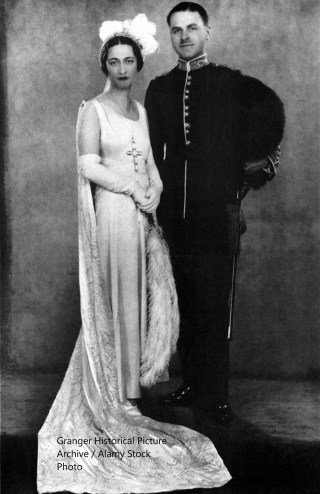 Wallis in her court dress
Wallis in her court dressOn 15 May, Wallis and her husband Ernest were invited by Thelma to a cocktail party she was giving for the Prince to celebrate his return from a tour of South America. The Prince of Wales whispered to Thelma that he thought he recognised Wallis and she reminded him of the weekend in January. He then told Wallis how much he had enjoyed that encounter. Shortly after their second meeting, Wallis was presented at court. As she was a divorcee, Wallis could only be presented if she was the injured party and she had to send her divorce papers to the Lord Chamberlain, hoping that she would be accepted – which she was.
On 10 June 1931, Wallis borrowed a dress, train, feathers and a fan from Thelma’s sister Consuelo and bought herself a large aquamarine cross necklace and white three-quarter-length gloves. Wallis dutifully curtsied for King George V and Queen Mary. The Prince of Wales was also present, and she overheard the Prince muttering something about the light making all the women look ghastly. Afterwards, Wallis and Ernest were invited over to Thelma’s house where the Prince was also present. He made an admiring remark about her gown to which Wallis retorted, “But Sir, I understood that you thought we all looked ghastly.” He was quite amused rather than offended and offered to drive Wallis and Ernest home that night.1
In early 1932, Wallis and Ernest entertained the Prince in their flat at Bryanston Court for the first time. He stayed until 4 a.m. and even asked for one of her recipes. At the end of January, they were also invited to spend the weekend with him at Fort Belvedere. Wallis was surprised to find him doing needlepoint. He told her, “This is my secret vice, the only one, in any case, I am at any pains to conceal.”2 Wallis also received a private tour of the grounds from the Prince. Over the coming year, they received regular invitations to the Fort, partly because Thelma was afraid of losing the Prince and she wanted to surround him was amusing guests.
In January 1933, Wallis found herself on ice skates alongside Thelma and the Duke and Duchess of York (the future King George VI and Queen Elizabeth). She also became acquainted with Prince George, later the Duke of Kent. When Wallis travelled to the US in March, she received a radiogram from ‘Edward P.” wishing her a good trip and a speedy return. After her return, the Prince threw her a birthday party, and she gave him a specially engraved Bryant & May matchbox for his birthday four days later, followed by an Independence Day dinner at their flat. Although she was slowly rising in the ranks, her and Ernest’s finances were suffering, and she had barely seen her husband in 1932 as he travelled a lot for business. More weekends at the Fort followed. Wallis could now clearly count herself amongst the Prince’s friends.
She began the year 1934 celebrating with the Prince until 5 a.m, following by dinner later that day, also with the Prince. Then came the trip that changed everything – Thelma was leaving for a trip to the United States, and according to Wallis, she asked, “I’m afraid the Prince is going to be lonely. Wallis, won’t you look after him?”3 According to Thelma’s memoirs, it was Wallis who initiated the topic with the words, “Oh, Thelma, the little man is going to be so lonely.” To which Thelma replied, “Well, dear, you look after him for me while I’m away.”4 Thelma sailed on 25 January 1934 – paving the way for Wallis to rise from friend to favourite.
The following day Wallis wrote to her aunt Bessie, “He will miss Thelma terribly but leaves himself in a couple of weeks.”5 The following weekend they were again invited to the Fort and the Prince came over for dinner. A few days later, he telephoned her directly for the first time to ask her to a dinner party.
That dinner took place on 30 January, and Wallis later wrote, “Before, the Prince had never dwelt upon his duties and the particular function he fulfilled in the imperial scheme of things. In fact, I deliberately kept the conversation from these topics, as if the subject of his working hours was something to be thrust aside in hours of relaxation. But on this particular evening, some chance remark of mine broke through his barrier, and suddenly, while the others, as I recall, were away from the table dancing, he began to talk about his work, the things he hoped to do, and the creative role he thought the Monarchy could play in this new age, and also dropped a hint of the frustrations he was experiencing. I was fascinated. It was as if a door had opened on the inner fastnesses of his character. What I now saw in his keenness for his job, in his ambition to make a success of it, was not dissimilar to the attitude of many American businessmen I had known. I cannot claim that I instantly understood him, but I sensed in him something that few around him could have been aware of – a deep loneliness, an overtone of spiritual isolation.”6
Something surely had changed. The Prince began visiting her home several times a week, and Ernest was surprisingly tolerant of the entire situation. He found ways to excuse himself as Wallis and the Prince talked until the small hours. On 12 February, Wallis wrote to her aunt, “I am sure the gossip will now be that I am the latest.” However, she was already a bit exasperated and ended the letter with, “Forgive me for not writing, but this man is exhausting.|7 On the 18th, she wrote, “It’s all gossip about the Prince. I am not in the habit of taking my girlfriends’ beaux.”8
Embed from Getty ImagesMeanwhile, the Prince had begun showering Wallis with gifts of jewellery and money and even a puppy. On 22 March, Thelma returned from the United States, and on the journey back she had seen much of Prince Aly Khan and rumours had found their way back to the Prince. She wrote in her memoirs, “Suddenly he said, ‘I hear Aly Khan has been very attentive to you.’ I thought he was joking. ‘Are you serious, darling?’ I asked. But the Prince did not answer me. At the Fort, the Prince, although formally cordial, was personally distant. He seemed to want to avoid me. I knew that something was wrong.”9
The following Easter weekend was spent at the Fort with Thelma and the Simpsons. Thelma wrote, “At dinner, however, I noticed that the Prince and Wallis seemed to have little private jokes. Once he picked up a piece of salad with his fingers, Wallis playfully slapped his hand… Wallis looked straight at me. And then and there I knew the ‘reason’ was Wallis… I knew then that she had looked after him exceedingly well. That one cold, defiant glance had told me the entire story.”10 Thelma left the following morning.
The reign of the new favourite had begun.
The post The Year of the Duchess of Windsor – Becoming the favourite appeared first on History of Royal Women.
January 22, 2021
Book News February 2021
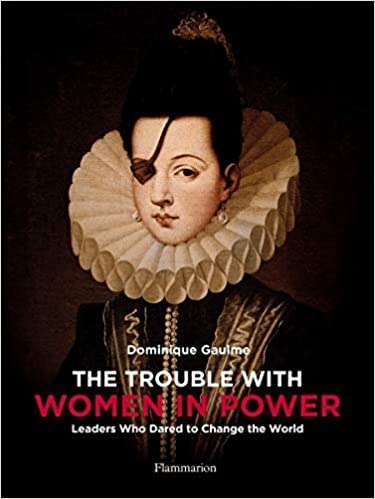
The Trouble with Women in Power: Leaders Who Dared to Change the World
Hardcover – 26 November 2020 (UK) & 16 February 2021 (US)
From Cleopatra to Margaret Thatcher, and from Christine Lagarde to Joan of Arc, this book focuses on powerful women across the centuries and geographical zones.
At the head of military operations, at the origin of revolutionary laws, dictatorial rulers or emblems of an entire people, these strong-willed women continue to fascinate and inspire. The text―richly illustrated by portraits, photographs, and mythical scenes―also addresses the question of their representations and their attributes of power.
In the history of world rulers, only a relatively small number of women have gained and retained places of power. In order to overcome misogyny, archaic laws governing inheritance, and the constraints of religious fervor, the women featured here incarnate exceptional determination and strength of character. Their stories―often riveting tales of courage in the face of injustice―offer fascinating and rich inspiration.
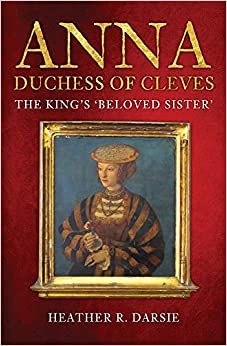
Anna, Duchess of Cleves: The King’s ‘Beloved Sister’
Paperback – 15 November 2020 (UK) & 15 February 2021 (US)
Anna was the ‘last woman standing’ of Henry VIII’s wives ‒ and the only one buried in Westminster Abbey. How did she manage it? Anna, Duchess of Cleves: The King’s ‘Beloved Sister’ looks at Anna from a new perspective, as a woman from the Holy Roman Empire and not as a woman living almost by accident in England. Starting with what Anna’s life as a child and young woman was like, the author describes the climate of the Cleves court, and the achievements of Anna’s siblings. It looks at the political issues on the Continent that transformed Anna’s native land of Cleves ‒ notably the court of Anna’s brother-in-law, and its influence on Lutheranism ‒ and Anna’s blighted marriage. Finally, Heather Darsie explores ways in which Anna influenced her step-daughters Elizabeth and Mary, and the evidence of their good relationships with her. Was the Duchess Anna in fact a political refugee, supported by Henry VIII? Was she a role model for Elizabeth I? Why was the marriage doomed from the outset? By returning to the primary sources and visiting archives and museums all over Europe (the author is fluent in German, and proficient in French and Spanish) a very different figure emerges to the ‘Flanders Mare’.
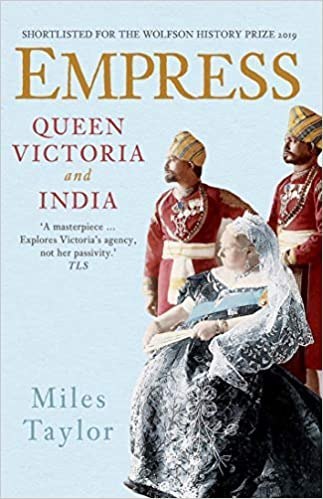
Empress: Queen Victoria and India
Paperback – 9 March 2021 (US) & 9 February 2021 (UK)
In this engaging and controversial book, Miles Taylor shows how both Victoria and Albert were spellbound by India, and argues that the Queen was humanely, intelligently, and passionately involved with the country throughout her reign and not just in the last decades. Taylor also reveals the way in which Victoria’s influence as empress contributed significantly to India’s modernization, both political and economic. This is, in a number of respects, a fresh account of imperial rule in India, suggesting that it was one of Victoria’s successes.
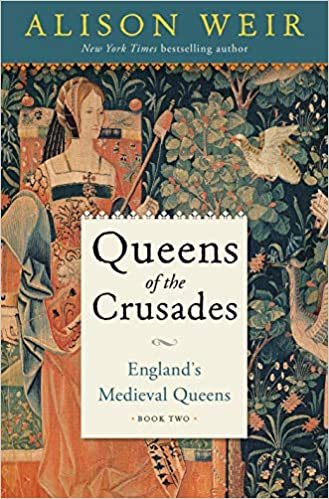
Queens of the Crusades: England’s Medieval Queens Book Two
Hardcover – 23 February 2021 (US & UK)
This second volume of Alison Weir’s critically acclaimed history of the queens of medieval England now moves into a period of even higher drama, from 1154 to 1291: years of chivalry and courtly love, dynastic ambition, conflict between church and throne, baronial wars, and the ruthless interplay between the rival monarchs of Britain and France. We see events such as the murder of Becket, the Magna Carta, and the birth of parliaments from a new perspective.
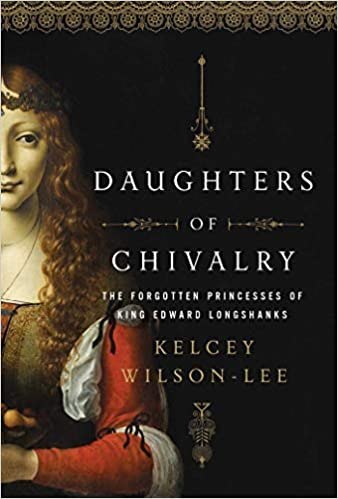
Daughters of Chivalry: The Forgotten Children of King Edward Longshanks
Paperback – 9 February 2021 (US & UK)
The lives of these sisters—Eleanora, Joanna, Margaret, Mary and Elizabeth—ran the gamut of experiences open to royal women in the Middle Ages. Edward’s daughters were of course expected to cement alliances and secure lands and territory by making great dynastic marriages, or endow religious houses with royal favor. But they also skillfully managed enormous households, navigated choppy diplomatic waters, and promoted their family’s cause throughout Europe—and had the courage to defy their royal father. They might never wear the crown in their own right, but they were utterly confident of their crucial role in the spectacle of medieval kingship.
Drawing on a wide range of contemporary sources, Daughters of Chivalry offers a rich portrait of these formidable women, seeing them—at long last—shine from out of the shadows, revealing what it was to be a princess in the Age of Chivalry.
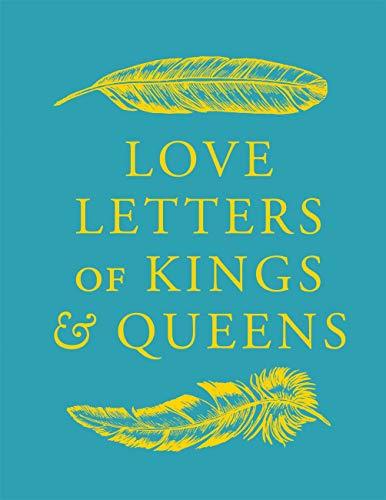
Love Letters of Kings and Queens
Hardcover – 4 February 2021 (US & UK)
Here is a chance to glimpse behind the pomp and ceremony, the carefully curated images of royal splendour and decorum, to see the passions, hopes, jealousies and loneliness of kings and queens throughout history. From Henry VIII’s lovelorn notes to Anne Boleyn to Charles II’s hot pursuit of Nell Gwynn to Queen Victoria’s tender letters to Prince Albert – these letters depict romantic love from its budding passion to the comfort and understanding of a long union, set against the background of great affairs of state, wars and the strictures of royal duty.
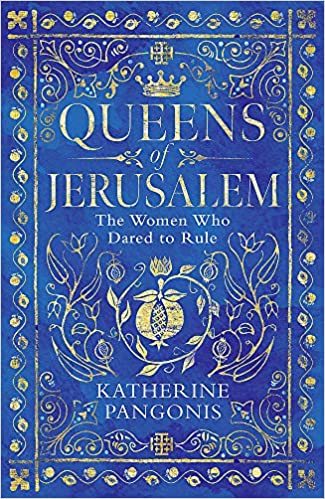
Queens of Jerusalem: The Women Who Dared to Rule
Hardcover – 13 May 2021 (US) & 18 February 2021 (UK)
The lives of this trailblazing dynasty of royal women, and the crusading Queen Eleanor of Aquitaine, are the focus of Katherine Pangonis’s debut book. In QUEENS OF JERUSALEM she explores the role women played in the governing of the Middle East during periods of intense instability, and how they persevered to rule and seize greater power for themselves when the opportunity presented itself.
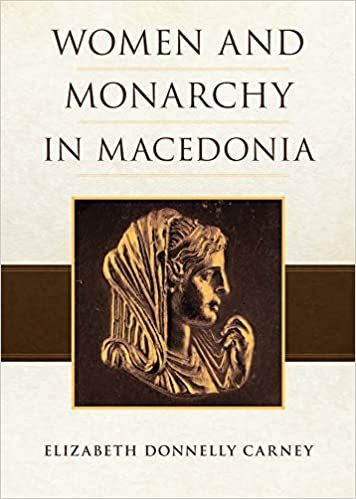
Women and Monarchy in Macedonia
Paperback – 16 February 2021 (US) & 28 February 2021 (UK)
In this groundbreaking work, Elizabeth Donnelly Carney examines the role of royal women in the Macedonian Argead dynasty from the sixth century B.C. to 168 B.C. Women were excluded from the exercise of power in most of the Hellenic world. However, Carney shows that the wives, mothers, and daughters of kings played important roles in Macedonian public life and occasionally determined the course of national events. Carney assembles an exhaustive array of evidence on the political role of Argead royal women. She also presents a series of biographical sketches describing the public careers of all the royal women – including Olympias, mother of Alexander the Great, and the warrior Cynnane, his half-sister – whose names are preserved in ancient sources.
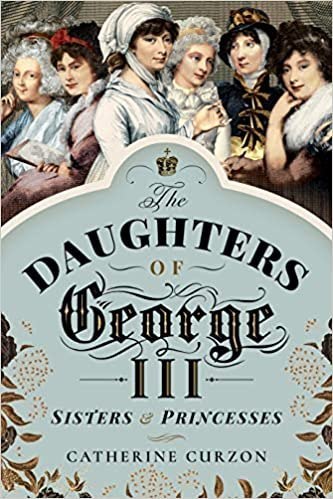
The Daughters of George III: Sisters and Princesses
Paperback – 28 February 2021 (UK) & 28 April 2021 (US)
In the dying years of the 18th century, the corridors of Windsor echoed to the footsteps of six princesses. They were Charlotte, Augusta, Elizabeth, Mary, Sophia, and Amelia, the daughters of King George III and Queen Charlotte of Mecklenburg-Strelitz. Though more than fifteen years divided the births of the eldest sister from the youngest, these princesses all shared a longing for escape. Faced with their father’s illness and their mother’s dominance, for all but one a life away from the seclusion of the royal household seemed like an unobtainable dream. The six daughters of George III were raised to be young ladies and each in her time was one of the most eligible women in the world. Tutored in the arts of royal womanhood, they were trained from infancy in the skills vial to a regal wife but as the king’s illness ravaged him, husbands and opportunities slipped away. Yet even in isolation, the lives of the princesses were filled with incident. From secret romances to dashing equerries, rumours of pregnancy, clandestine marriage and even a run-in with Napoleon, each princess was the leading lady in her own story, whether tragic or inspirational. In The Royal Nunnery: Daughters of George III, take a wander through the hallways of the royal palaces, where the king’s endless ravings echo deep into the night and his daughters strive to be recognised not just as princesses, but as women too.
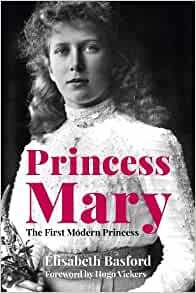
Princess Mary: The First Modern Princess
Hardcover – 1 February 2021 (UK) & Unknown (US)
Princess Diana is seen as the first member of the British royal family to tear up the rulebook, and the Duchess of Cambridge is modernising the monarchy in strides. But before them was another who paved the way. Born in 1897, Princess Mary was one of the hardest-working members of the royal family, known for her no-nonsense philosophy. During the First World War she came into her own, launching an appeal to furnish every British troop and sailor with a Christmas gift, and training as a nurse at Great Ormond Street Hospital. As the only daughter of King George V and Queen Mary, she would live to see not only two of her brothers ascend the throne but also her niece Queen Elizabeth II. In the first biography in decades, Elisabeth Basford offers a fresh appraisal of a princess who redefined the title for the modern age.
The post Book News February 2021 appeared first on History of Royal Women.
January 21, 2021
Maria of Bytom – A Queen in the footnotes
Throughout the late middle ages, there are records of queens whose marriages were beneficial to their husbands’ families. Even though we don’t know much about them, we still know whether or not they fulfilled their most important duty – bearing sons. Often the queens who did not succeed in this are forgotten and hidden in the footnotes. One such queen was Maria of Bytom, the wife of King Charles I of Hungary.
Facts about Maria of Bytom are so obscure; we even don’t know if she was the first or second wife of Charles. Maria was the only recorded daughter of Casimir, Duke of Bytom, and his wife, Helena. She had at least five brothers. Maria’s father, Casimir, belonged to a lesser branch of the Silesian branch of Poland’s ruling Piast dynasty. The origins of her mother, Helena, are unknown, but she is sometimes thought to have been from the Rurik dynasty, which ruled over present-day Russia and Ukraine. The Rurik prince who is thought most likely to her been Helena’s father is Leo I, King of Galicia. The name Maria was rarely used in the Piast dynasty, so it’s thought to have come from her mother’s side.
First or Second Wife?
Maria of Bytom was probably born between 1290 and 1294. She is believed to have married Charles of Anjou, claimant to the crown of Hungary, in 1306. This is evidenced by a charter from 1306, which mentions Queen Maria of Hungary. However, some believe this may refer to Charles’ grandmother, Maria of Hungary, Queen of Naples, who used the title of Queen of Hungary after the death of her brother, Ladislaus IV, in 1290. However, it is also augured that it is not this queen because she titled herself Queen of Hungary, Sicily, and Jerusalem. This makes it more likely that this Maria mentioned was a wife of Charles.
There is confusion about if Maria of Bytom was Charles’ first wife and when she married him. One chronicle mentions that Charles married a daughter of Leo II, King of Galicia, in the first half of 1308. Others say this could have happened in 1305 or 1306. However, Leo II seems too young to have been the father of Maria of Galicia if she existed.
Another argument for the Galician marriage is the fact the Charles stated in a charter in 1326 is that he once went to Galicia to bring his first wife back to Hungary. Yet the Illuminated Chronicle, which was written during the reign of Charles’ son, Louis, says that Maria of Bytom was indeed his first wife. There are some explanations for the conflicting reports. Some believe that there was indeed a marriage arranged between Charles and Maria of Galicia, but she died before it could happen, or that the contract was broken off. Another belief is that Maria of Bytom was a granddaughter of Leo I of Galicia through her mother, Helena.
Queen of Hungary
What we do know for certain is that by 1311, Charles had married Maria of Bytom. Around 1305, Casimir of Bytom obtained 140 pieces of silver, and this was probably used to pay the wedding expenses. This makes the 1306 date more likely. The wedding probably took place in Maria’s hometown of Bytom. Soon after the wedding, Maria would have headed to Hungary with her new husband and been crowned Queen at the coronation Basilica of Szekesfehervar.
The reasons for this marriage are uncertain. If the Galician marriage happened, it would have probably been more beneficial for Charles’ international standing. It is important to mention that Maria and Viola of Teschen, Queen of Bohemia, were first cousins through their fathers. Wenceslaus III of Bohemia married Viola in 1305. From 1301 to 1305, Charles and Wenceslaus were rival claimants to the crown of Hungary, so possibly the marriage of Maria and Charles was a response to the Bohemian marriage. Maria and Viola were about the same age. The exact reasons for the marriage of Wenceslaus and Viola are uncertain too. Just like Viola, Maria was described as being very beautiful. Sometimes Wenceslaus is thought to have chosen Viola because of her beauty, so maybe this could be why Charles chose Maria. However, this seems unlikely, and these marriages probably offered political benefits. The marriage of Maria was probably for a Hungarian-Polish agreement directed against Bohemia.
From 1301 to 1305, Charles was fighting for the crown of Hungary against Wenceslaus III of Bohemia, and then from 1305 to 1308, he was up against Otto III of Bavaria. In November 1308, he was finally proclaimed King of Hungary and would have two coronations, first in 1309 and then in 1310. Maria may or may not have been crowned alongside him at the first coronation, but she is known to have been crowned with her husband at the second.
Maria did not play a big role in the Hungarian court. Not much is known as her life as queen. There are two documents issued by Maria between 1312 and 1313. There is also a letter from her to Charles, asking for permission to donate land to a youth in her service. Maria had her own seal as queen. In 1315 Maria invited two of her brothers, Boleslaw and Mieszko to the Hungarian court. Both brothers would have prominent church careers in Hungary and would go on to be bishops.
Maria most likely had no children. However, some later sources say that she and Charles had two daughters who married into Maria’s Silesian Piast family; Catherine, who married Henry II, Duke of Swidnica, and became the mother of Anna of Swidnica, Holy Roman Empress, and Elizabeth, who married Boleslaw II of Niemodlin. This is most likely false, for contemporary sources say that Maria had no children. Some think that Charles’ third wife, Elizabeth of Poland, was their mother instead, but that’s also unlikely. Contemporary sources mention five sons but no daughters for Elizabeth. Also, Catherine and her husband, Henry, would have been first cousins if Elizabeth were her mother. It’s possible that Catherine and Elizabeth were illegitimate daughters of Charles, or they could not have been his daughters at all. While Catherine certainly existed, the existence of Elizabeth is less certain. Her alleged husband, Boleslaw, is said to have never married.
Maria died on 15 December 1317, in Timisoara, where the Hungarian court was based at the time. She would have been in her twenties, and the cause of her death is unknown. Interestingly, her cousin, Viola of Teschen, whose life was parallel to hers, died a few months earlier. Maria was buried in Szekesfehervar Basilica, the burial place of many previous kings and queens of Hungary. Charles married twice more, firstly to Beatrice of Luxembourg, and then to Elizabeth of Poland, who gave him his long-awaited heirs.1
The post Maria of Bytom – A Queen in the footnotes appeared first on History of Royal Women.
January 19, 2021
The Year of the Duchess of Windsor – The Accession of King Edward VIII
“It’s all over.” 1
King George V’s health had been worsening since the autumn of 1935 after his return from Balmoral. He had been unable to lay his wreath on the Cenotaph on 11 November and had not gone out shooting at Sandringham. His favourite sister Princess Victoria died on 3 December and King George was devastated. He cancelled the State Opening of Parliament which had been set to take place that afternoon, and he would not appear in public again.
Four days before Christmas, King George and his wife Queen Mary travelled to Sandringham by train as usual. The family proceeded to have normal Sandringham Christmas – presents on Christmas Eve and listening to the King’s Christmas message. On 31 December, they watched Monte Cristo. Although George went out riding on his white pony named Jock in those early January days, he was already seriously unwell. On 14 January 1936, George went outside for the last time. The following day, he ate dinner in his bedroom. Mary wrote, “Poor George, who had not been feeling well for some days, felt worse & had to go to bed before dinner.”2 The following day he “had a cold & stayed in his room all day, not in bed all the time – Most worrying.”3
On 17 January, the chief physician Lord Dawson of Penn was summoned, as was the Prince of Wales who was shooting at Windsor. Mary wrote to her eldest son, “I think you ought to know that Papa is not very well.”4 Wallis also happened to be there when the note was delivered. She later wrote, “I happened to be at the Fort that afternoon and was in the drawing-room when he came in with the note in his hand. Without a word, he gave it to me to read. He disappeared, and I heard him telephoning the pilot to have his aeroplane ready the next morning to fly him to Sandringham.”5
The Prince of Wales arrived at Sandringham the following day, and he wrote to Wallis, “My own sweetheart, just a line to say I love you more and more and need you so to be with me at this difficult time. There is no hope whatsoever for the King it’s only a matter of how long and I won’t be able to get up to London if he’s worse. But I do long long (sic) to see you even for a few minutes my Wallis it would help so much. Please take care of yourself and don’t get a cold. You are all and everything I have in life and WE must hold each other so tight. It will all work out right for us. God bless WE.”6
King George would spend his final days in an old Tibetan dressing-gown in front of a fire, and slowly other members of the family began to arrive. The Prince of Wales drove to London on 19 January to inform the Prime Minister, Mr Baldwin, that the King was dying. Mary wrote, “G. about the same. Sat with him from time to time – Did not go to church as the place was surrounded by reporters & photographers, too heartless – Walked with Mary morning & afternoon – Wigram came with us – George (the Duke of Kent) arrived at 7 – also Archbishop of Canterbury – David (the Prince of Wales) & Bertie (the Duke of York) left but will return tomorrow.”7
Regular bulletins were issued regarding the King’s health, including perhaps the most famous one – issued on 20 January – “The King’s life is moving peacefully towards its close.” King George V died just before midnight on 20 January 1936, helped along by “morphia gr 3/4 & shortly afterwards cocaine gr 1 into the distended jugular vein…”8 Mary took the hand of her eldest son, stooped and kissed it. The Prince of Wales was now King Edward VIII. Not much later, he called Wallis. She later wrote, “Shortly after midnight, as I was getting ready to leave, I was called to the telephone. It was David speaking from Sandringham. ‘It’s all over,’ he said. I could think of nothing better to say then, ‘I am so very sorry.’ Then he said, ‘I can’t tell you what my own plans are, everything here is so very upset. But I shall fly to London in the morning and will telephone you when I can.’ It was only as I hung up that I realised that David was now King.”9
In late January, Wallis wrote to her aunt Bessie “I have had to be at the new King’s beck and call, being the only person he has to really talk things over with normally, and it has all been a great strain. The ceremonies have been marvellous and impressive as only this country can produce and the proclamation of Edward XVIII (sic) the most picturesque things – such costumes from the Middle Ages, the heralds looking like a pack of cards.”10
On 22 January, Wallis watched from an unused apartment at St. James’s Palace onto Friary Court as the Garter King of Arms proclaimed the new King. Suddenly the King himself turned up against tradition and joked to his assistant private secretary, “Godfrey, this may strike you as somewhat unusual, but the thought came to me that I’d like to see myself proclaimed King.”11 Her presence was noticed by Lady Diana Cooper who mentioned it to her husband Duff Cooper, Secretary of State for War, who wrote, “This is just the kind of thing that I hope so much he won’t do. It causes so much criticism and does so much harm.”12 They were also briefly caught on camera as they looked out the window.
The post The Year of the Duchess of Windsor – The Accession of King Edward VIII appeared first on History of Royal Women.



